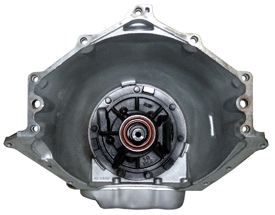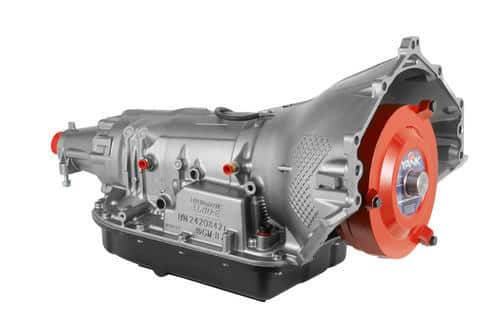Why use a 4L80E and not a 4L60E?
The 4L80E is a descendent of the proven TH400 transmission design. It is very rugged, has much more potential for power capacity than any other overdrive transmission on the market. It has better power flow for big power applications, much more clutch capacity and apply area than the 4L60E. Simply put, from a design and engineering perspective, it’s a superior transmission in more powerful combinations. Eyetv 3.6 9 serial. It’s not for everyone, but it is the unit of choice if you plan to make serious power.
GM 4L80E Automatic Transmission Introduction. The 4L80E transmission is the advanced progeny of the legendary TurboHydramatic TH400 automatic transmission, and is based heavily on the 400 in both parts and strength, yet featuring an added overdrive gear, a lock-up torque converter and advanced electronic controls. The 4L80E is a computer controlled transmission and the successor to the TH400. Identification of the 4L80E is pretty easy. If you use the process of elimination, there are only a few transmissions that it can be. The transmission itself has been around since 1991, and the case has changed a bit like the 4L60E/700R4 twins. The 4L80E is essentially a TH400 with an overdrive gear added.
What about HP loss or consumption?
The 4L80E will theoretically consume more HP than a 4L60E or other lighter duty transmission. It has a positive displacement pump as opposed to a variable displacement, it is heavier, has more rotating mass, more clutch drag, and on the surface would seem to “eat” HP. The biggest loss would seem to come from the heavier rotating mass. However what is widely misunderstood is that yes it’s heavier, but that alone doesn’t cause more power loss. Remember an object in motion tends to stay in motion unless acted upon by another force. So unless there is more friction involved, a heavier rotating mass doesn’t take any more HP to maintain the same speed as a much lighter mass. It DOES take more power to accelerate or decelerate the heavier mass. So what this means to the average enthusiast is the faster your car, the more power the transmission will consume. This applies to all transmissions. Power loss through the transmission will increase the faster you accelerate it. Our testing has shown that you will not see any significant power loss in a 11, 12 or 13 second combination. They simply aren’t accelerating fast enough that the rotating mass really comes into play. As you get into the low 10 second ¼ mile times, you may start to see some differences between a lightweight transmission and a heavier one. The thing to remember is, typically the lighter duty transmissions become a maintenance item at these power levels. More frequent rebuilds and failures. So for a small loss of power often equating to less than .05 second in Elapsed Time in the ¼ mile, you gain reliability. Unless you are racing for a record attempt where hundredths of a second are crucial, reliability is usually a more important factor.

What about size/weight of the 4L80E?
The 4L80E weighs 178 lbs in typical configuration. A 4L60E weighs approx. 135-140 lbs, a TH400 weighs 135 lbs, a TH350 weighs 125 lbs. All weights are without converter and dry with stock components. Converter weights will be similar for a given combination with the same size converter. i.e. 12”, 9.5”, 8”.
The 4L80E is very close to the same length as a 4L60E. Oftentimes we have swapped these units out without cutting the driveshaft, just a yoke change. It is more robust in the area behind the bellhousing than most other units. This is also the area where the cooler lines attach. The biggest fitment issue we see is in the cooler line area. Part of the issue is that the cooler lines on a 4L80E are not angled but come straight out of the case. In some cars the early cores (91-96) fit better than the 97-up cores due to the cooler line placement. Leonard cohen discografia mega. We know from various installs that the 4L80E fits fairly easily in the 67-69 GM F-Body cars (Camaros Firebirds, and typically X-body Nova’s), 70-81 F-Body. 98-02 F-Body. 68-72 A-Body (Chevelles, Cutlass, GTO, etc), as well as the 78-87 G-Body cars (Malibu, Regal, Cutlass). We have customers who have installed them in 64-67 Chevelles with minor floorpan work.
4l80e Transmission 6 Speed

What are the differences in the cores?
4L80E production started in 1991 and continues today. 1991-1996 cores are essentially the same and interchangeable with some minor updates and differences. The 1991-1993 cores had a poor electrical connector at the pass-through of the case. Many have been updated by now, and if not they would need a new harness anyway. The cores do not have provisions for bolting on a manual lever position switch (MLPS). 1994-1996 cores had an updated EPC (electronic pressure control) solenoid and some have the longer shifter shaft to allow use of the MLPS. All of the 1991-1996 cores have the “old” lubrication circuit design where both cooler lines attach to the case just behind the bellhousing. They also have the larger overdrive roller clutch, typically came with a 16 element instead of a 34 element intermediate sprag, and are of the traditional bellhousing bolt pattern used on SBC and BBC engines.
1997-1999 cores have the “new” lubrication circuit that has one cooler line attaching to the case
just behind the bellhousing, and the return line attaches several inches further to the rear. Battleship full movie tamil dubbed. This was supposed to be an improvement to the lube circuit that “center lubed” the transmission, allowing better lubrication to the rear planetaries. These units still had the traditional bellhousing bolt pattern.
2000-2003 cores are similar to the 1997-1999 cores yet they added a bellhousing bolt position to the 12 o’clock position of the bell for the new LS series engines.
2004-up cores had some slight valve body changes and another EPC change.
We build all year model cores and feel they can all be built and work well. In bigger power applications, we prefer the early larger OD roller clutch setup. The type of lubrication circuit doesn’t seem to be an issue when properly built.
What about using an early model core on an LS engine with the missing bellhousing bolt?

We have many customers using the early cores behind LS engines. You will still have 5 bellhousing bolts instead of 6, and this is the same thing as installing a TH400, TH350, or Powerglide behind these engines. In a perfect world we would use a late model core behind the LS engines and be able to use all the bellhousing bolts. However the core costs are still much higher on the later model cores because GM is still buying these back for their rebuild program.
4l80e Rebuild Kit
What about a converter cover?
Many of our performance customers are not using a cover. In a more drag racing oriented combo leaving it off allows better converter cooling. In a work truck, off-road, or mud racing combo we recommend installing a cover for protection. We do not provide these with our units as they typically don’t come in on the cores. They can be sourced through GM or a wrecking yard depending on the year of the core.
What type of fluid should be used?
In most applications, regular Dexron III type fluid is fine. Dexron VI or synthetic is also fine but not necessary. In some very harsh conditions, the use of tractor transmission/hydraulic fluid can help fluid and clutch life. This fluid is clear and harder to see on the dipstick. It is equivalent to Caterpillar TO-4 fluid and is available in different viscosities. We recommend using the low viscosity if you decide to use it unless you are trying to use it to tighten up the converter stall slightly. We do not feel Type F fluid is up to modern specs but it will not harm anything to use it.
How much power can the 4L80E handle?
A totally stock unit or rebuild will typically live well with up to 450 flywheel HP/TQ. Above this point the direct clutches will not live long without some hydraulic improvements.
Using our modifications or some valve body kits, the direct clutch issues are resolved and the 4L80E will generally be reliable up to the 750 HP/TQ range unless it’s a very heavy combination (over 4500 lbs) or using nitrous.
The weak point above this power level becomes the OEM input shaft. An upgraded input shaft becomes mandatory. We like to upgrade the forward hub at the same time.
The next real weakness is the stock 34 element sprag. This part is actually capable on a well built unit of living at over 1000 HP/TQ BUT it requires care and knowledge by the end-user. Knowledge of proper burnout procedures is critical. It will also be a maintenance item at the 1000 HP level. It will need to be inspected/replaced occasionally depending on how the unit is used.
We recommend upgrading to a “Super Drum” style sprag that requires a modified or custom made drum and race. It has 36 elements that are wider, a larger race, and uses more intermediate frictions. If it fits in your budget, this is always an excellent upgrade above the 750 HP/TQ range. Combined with the input shaft and forward hub upgrade, it makes the 4L80E almost bulletproof.
How does a Jake’s Performance 4L80E differ from a competitor’s?
Many of our parts are of our own design. We engineered the 4L80E transbrake that has become so popular and is used by other companies. We don’t just build the units but we constantly R&D new parts. Some of our own and some from competitor’s. We also select the parts we use. Many builders use upgraded, aftermarket parts such as the forward hubs, Super Drum, and aftermarket planetary gearsets. We don’t just use what’s cheapest or most commonly available like many builders. We select the parts based on what is better engineered, more reliable, or fits the application better. We may not be the lowest cost but we back up our product and take care of the customer. We don’t have to run an advertising blitz on the internet to get business, we rely on our reputation. Each unit is built using proven techniques and parts and then dyno tested before it ships. The unit is stamped with a number and the builder, dyno pressures, and other notes are recorded for warranty purposes. We have 4L80E’s living in extreme environments at over 1400 HP. The same care of assembly goes into our base build Stage II units as our more expensive builds.
4l80e Gear Ratios

What size thread do the cooler lines use?
1/4″ national pipe; straight milled
